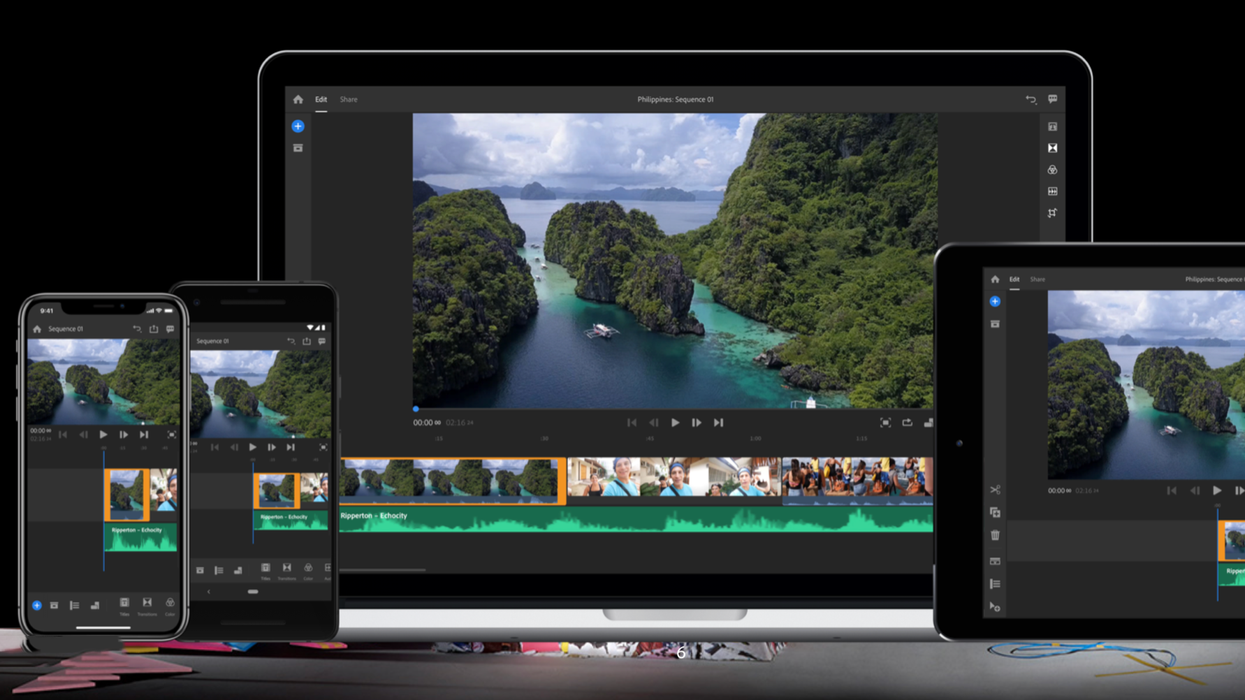Adobe Premiere Rush Makes Editing Anywhere You Want to Be Easier
Download on set, edit on the train ride home, and seamlessly deliver with the new Premiere Rush.

Filmmakers have been dreaming of a "free" workflow for decades. From the first time we could get editing software working on a laptop (and our first question was what kind of hard drive would hold the media), the dream of being able to edit wherever we are—be it on set, on location, in transit, or back at the office—has been a powerful one.
With its new Premiere Rush (previously available as a beta Product Rush), Adobe is pushing hard into that dream with a platform that allows projects to seamlessly, automatically move between your desktop and mobile devices.
In the dream scenario, you either shoot with your phone or download your footage on a laptop into a Rush project on set. Once in Rush on any system, you should be able to open your rush project on any other system, including going back and forth between the Rush desktop app and the Rush iOs app on either an iPad or an iPhone, with an Android version to follow.
The Rush toolset is limited, but it's clearly been designed from scratch to try and balance the desire for powerful edit controls with the ease of a touch interface. Built around a design philosophy of "progressive revelation," your timeline starts as a single track, with video and auto together in a single clip.
Only when you want to start editing your audio does "audio" appear as a track. New video and audio tracks only appear when you ask for them. While it might throw some longtime editors off, we actually kind of like it, especially in terms of making life simpler in the timeline.
Premiere Rush takes your media and automatically creates proxies in H2.64 on the creative cloud servers. This is easy if you shot with your cell phone, which will usually shoot straight to H.264 or H2.65 HEVC, but is something to be conscious of if you are, for instance, starting a project with ProRes files on your desktop. Premiere Rush will create those proxy files, stick them on the cloud, and then when you fire up the project on your iPad, it will automatically be working off of those online H.264 proxy files and will do exports to platforms like YouTube and Vimeo.
For the most part, this will be absolutely fine, but for a few certain situations, this will be frustrating. To solve that issue, on a desktop you can convert a Premiere Rush file to a Premiere CC file, allowing you to work from the ProRes files again and do your finishing from your higher res media.
One thing to be aware of is that the journey can only go one way: you can take projects out of Rush and into "full power" Premiere, but you can't go backward, taking a project from Premiere into Premiere Rush. This makes sense as Premiere projects are complicated and would need to throw out a lot of data and options in order to fit in the Rush paradigm, but it's also a hair disappointing, since how wonderful would it be to work in Premier all day and then open up Rush at home when you realize you forgot to make a small tweak. Someday, maybe, that will be a thing, but right now, we're just not there.
We got to spend hands-on time with a pre-release of Rush and found it very enjoyable and surprisingly powerful. This isn't a tool that we would use for editing a documentary feature, for instance, but rather for smaller projects, tutorials, social video, and anything with a tight turnaround. We actually think there is a really powerful option here.
The biggest thing is the flexibility of where you work. We can't tell you the number of times we've worked on an edit before going home and hearing from a client that they had a title wrong or wanted to swap out an asset, requiring a trip back to the office to make the fix. For projects that are simple enough to work in Rush, we think the benefit of more freedom of where to work will make the sacrifices of the more limited toolset worth it.
Of course, once that happens it will be harder than ever to avoid responding to clients emails at night and on weekends, but that isn't Adobes fault.
Available now, check out the Adobe site for more.
Tech Specs:
- Mac, Windows, iOs
- Android Coming Soon
- H.264 server based workflow
- Titles, and Lumetri Color Panels
- Can move from Rush to full Premiere
- Exports directly to vimeo, youtube, and more














